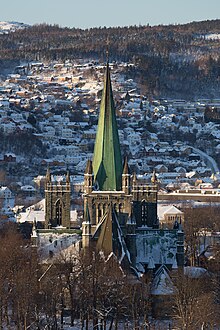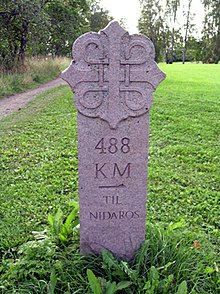|
Pilgrim's Route    The Pilgrim's Route, (Norwegian: Pilegrimsleden) also known as St. Olav's Way or the Old Kings' Road, was a pilgrimage route to the Nidaros Cathedral in Trondheim, Norway. The cathedral is the site of the medieval tomb of St. Olav. The main route is approximately 640 kilometres (400 mi) long. It starts in the ancient part of Oslo and heads north along the lake Mjøsa, up the Gudbrandsdalen valley, over the Dovrefjell mountains, and down the through the Oppdal and Gauldalen valleys to end at the Nidaros Cathedral.[1] RouteAlthough the Pilgrim's Route over the Dovrefjell mountains is only one of several pilgrimage routes in Norway, it is arguably the most famous. It connected the historically important Norwegian cities of Oslo and Nidaros (now Trondheim).[2] Oldest known routeThe oldest known route over the Dovrefjell mountains which followed the Lågen river valley at the Kongsgården (lit. 'King’s Farm') at Tofte, just past Dovre Church in Dovre Municipality (slightly south of present-day village of Dombås). It followed a lower and more easterly route which followed the drainage to the east of Tofte, and then proceeded over the Dovrefjell mountains to join the route in Oppdal Municipality.[2] King's WayThe "King's Way" traveled up through the Gudbrandsdalen valley and left the Lågen river valley at Tofte Kongsgården (lit. 'King’s Farm') shortly past the Dovre Church in Dovre Municipality (just south of present-day village of Dombås). This route went more directly over the Dovrefjell mountains into Oppdal Municipality.[3] SheltersThe historically heavy stream of pilgrims which visited the shrine of St. Olaf in Trondheim annually prior to the Reformation resulted in the erection of mountain stations (Norwegian: fjellstue) where the pilgrims could find food and shelter. Stations were erected at Kongsvoll, Drivstuen, Fogstuen, and later at Hjerkinn.[4] In speaking of the route, Knut Gjerset quotes Peder Claussøn Friis as writing in the late 16th century, "But in the winter people of high estate, as well as members of the court, travel mostly this way, because however high and deep the snow may fall, it blows together on the high mountains and becomes so hard men and horses can walk on it. The bonder [farmers] run over it on skis and snow-shoes. There are three stations: Drivstuen, Herdekinn and Fogstuen built on this same mountain in order that travelers may find lodging there...at the stations there are implements and dry wood, so that the traveler may build themselves fire, and not suffer from cold, when they have to remain over night, and cannot find the way across the mountain."[5] HistoryThere is clear evidence that this route had seen heavy use in the early Norwegian Iron Age. Oppdal on the route was located at a crossroads for traffic from Trondheim, traffic over the Dovrefjell mountain range, and the Sunndal on the west coast. At Oppdal there are over 700 Viking Age grave mounds indicating that Viking trade routes passed through these valleys. It is appropriately termed "The King's Road". Virtually every king of Norway traveled this road. Those for whom we easily find records of their passage range from the first King of Norway through the last King able to pass that way before the road was completely replaced with modern rail and tarmac. Harald Fairhair or Harold I was the first king of all Norway who crossed the Dovrefjell on The King's Road. Harald Hårfagres saga describes an expedition he led up the Gudbrandsdal, and north over Dovrefjell on his way to success at the battle of Orkadal.
Kings
Railway linesThe Norwegian railway line Rørosbanen was opened on 13 October 1877, connecting Hamar and Trondheim via the towns of Elverum and Røros. At this point, the difficult route up through the Dovrefjell mountains lost most of its appeal, compared with the relative ease of taking a train to Trondheim. The final end came on 17 September 1921, when the Dovre Line was completed. Starting at Dombås in Dovre municipality, it passes over the mountainous stretches of the Dovrefjell, before merging with the Rørosbanen again at Støren. It passes close to the Old King's Road's historic route, but is to the west along a route which, although longer, has a lesser grade, as is required for rail. Present-day routeAlthough the Pilgrim's Route fell into disuse with the arrival of the railroad, it has recently been revived. Today it is promoted and is used by modern travelers as a long-distance hiking trail. There is a Pilgrim's Office in Oslo which gives advice to travelers and a Pilgrim Centre in Trondheim, under the aegis of the Nidaros Cathedral, which awards certificates to successful travelers upon the completion of their journey.[8][9] See alsoReferences
Other sources
External links
|
Portal di Ensiklopedia Dunia